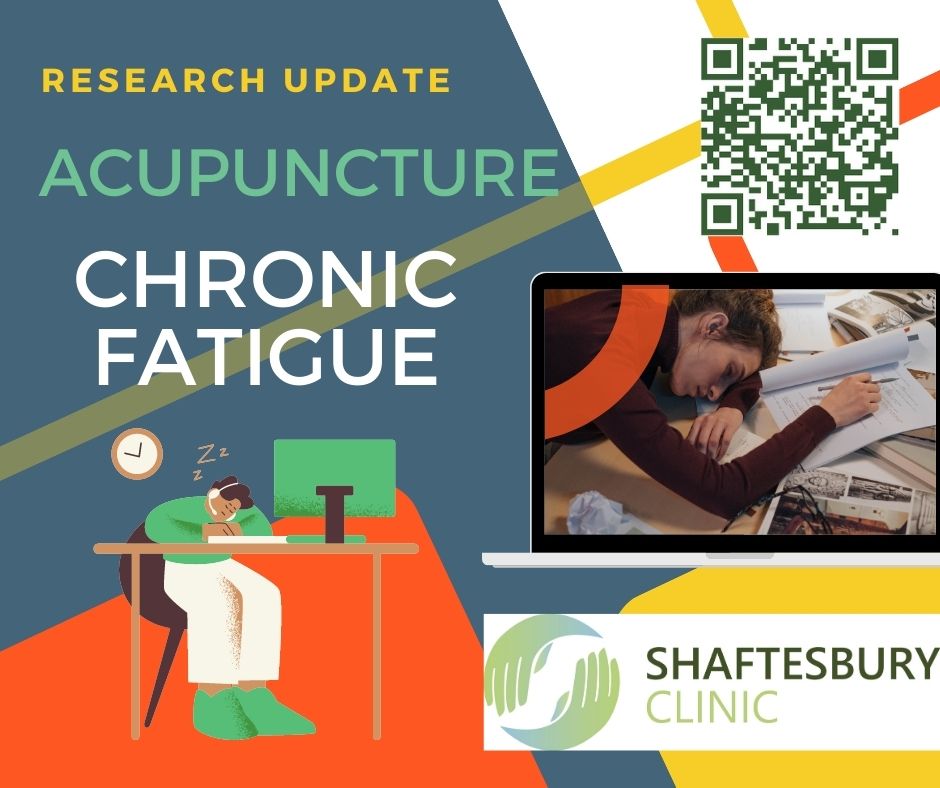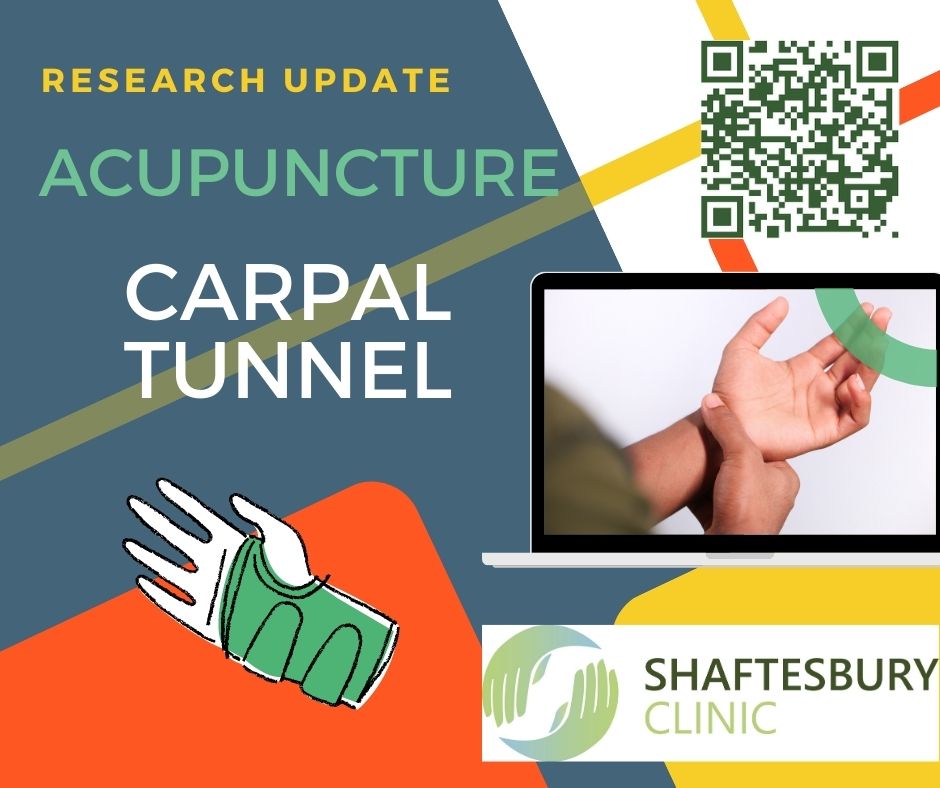Chronic Fatigue Syndrome (CFS) is also known as Myalgic Encephalomyelitis (ME).
Important to know: Chronic health conditions should be addressed under direct medical supervision of your GP or consultant, and acupuncture would be an adjunct or complement to usual care – we advise that you let you doctor know when you use this approach.
A scholarly search of the available research papers on the terms “acupuncture” + “chronic fatigue” yields over 11,500 papers, and narrowing this to “RCT” to identify Randomised Controlled Trials, gives over 1,200 results; of which one third of these have been carried out since 2017 (Google Scholar). This suggests that acupuncture is being used traditionally and currently in this area, research has been carried out, the pace of which is increasing in recent years, and as such that it has been recognised its potential role is worthy of appraisal in a scientific manner.
Interpreting the research:
When reading health research, it is important to know that Systematic Reviews or Meta Analyses of a large number of high-quality research studies are the very best way to be able to say to what extent a given treatment can address a condition, symptom, or set of symptoms. The next best level of evidence is the individual Randomised Controlled Study (RCT) which uses a systematic technique to compare two or more groups of patients receiving different treatments (or a treatment against a “control”, or no treatment). In acupuncture trials, the nature of the control group is of particular interest as it is hard to blind a patient to whether they are having a needle inserted or not, and even more challenging to blind the researcher/team to this.
The means and quality of how research is carried out varies considerably from country to country, and in terms of how an intervention is compared to another intervention (or a control). Of note is the fact that “sham” acupuncture (where needles are placed in apparently inert locations rather than traditional acupuncture points) is not really an inert process as it has physiological effects, so that comparing sham and “true acupuncture” may therefore not give a clear picture alone; but and form a part of a research body where acupuncture versus no treatment, vs conventional treatment or vs a different approach/modality also form part of the evidence base.
The n= figure (where quoted in research) tells you how many people were participants in the study, and usually the larger a study (when it is of good quality and design), the more likely it is to be reliable and applicable to larger populations. When (statistical) “significance” is discussed in view of studies it has a very particular meaning – it is the confidence in the data (using statistical tests) that tells us how likely a result could have just come about by chance. The lower the possibility of a chance result, the more likely it is due to the intervention in the experiment. When you are reading a trial/study, the “p” is the number telling us of significance, and this must be under 5% (or p less than 0.05) to mean we can say it is a (statistically) “significant” result.
The Research:
A number of systematic reviews have been carried out in this area, these include Wang, T. et al (2017, 31 RCT’s); Wang, J.J. et al, (2009, 28 RCT’s); Yin et al, (2020, 10 RCT’s); Kim et al, (2017, 11 RCT’s); Son (2009, 53 RCT’s); all concluded along the lines that whist overall the trends appeared positive, this is a tentative conclusion as further studies are needed due to the fact that a number of RCT’s examined suffer from poor quality research design; and in some cases findings were contradictory.
A protocol for a systematic review on the efficacy and safety of moxibustion for chronic fatigue syndrome was published this year (Xue et al, 2021), this will be of interest as moxibustion is the using of a warming herb on acupuncture points (commonly employed by traditional acupuncturists as an adjunct to acupuncture treatment). Furthermore, a protocol for an overview of systematic reviews in this area has been published recently (Tang et al, 2021), the forthcoming result of this will be of interest within the context of the existing research body.
Mechanisms of action:
Acupuncture studies have shown it can: provide pain relief by stimulating nerves in body tissues and leading to endorphin release (natural painkilling substances), as well as downregulating the brain and nervous system’s reaction to stress and pain (Zhao 2008; Zijlstra et al, 2003; Pomeranz, 1987).
Acupuncture stimulates the body to create its own natural painkilling substances, such as Beta Endorphins (β-Endorphin). In studies acupuncture has been shown to stimulate the production of natural painkillers called opioid-like peptides (OLPs), including β-Endorphin: For example, this was shown in an RCT in 90 patients with a range of painful disorders (Petti et al, 1998). The same study showed acupuncture also and enhanced the activity of immune cells (lymphocytes, natural killer cells and monocytes) that help fight infections and diseases (Petti et al, 1998).
Acupuncture can activate mast cells at acupoints, which release histamine, serotonin, adenosine, and other mediators that modulate nerve transmission and inflammation (Li et al, 2022)
Zijlstra et al (2003) reviewed the effects and mechanisms of acupuncture in treating various inflammatory diseases and conditions. They proposed the mechanisms of action:
- Acupuncture may release neuropeptides from nerve endings that have vasodilative and anti-inflammatory effects through CGRP.
- Acupuncture may also interact with substance P, which is involved in pain transmission and inflammation.
- Acupuncture may influence the balance between cell-specific pro-inflammatory and anti-inflammatory cytokines such as TNF-α and IL-10.
Acupuncture has been shown in animal models to promote the release of factors that involved in the reduction of inflammation (vascular and immunomodulatory factors – (Kim et al, 2008; Kavoussi and Ross, 2007 [review article]; Zijlstra et al, 2003), and also to affect levels of serotonin (in an animal model), and other peptides in the brain and nervous system and modulate blood flow in the brain and elsewhere in the body, in humans (Zhong and Li, 2007; Shi et al, 2010).
Electroacupuncture (EA) has been shown in a rat model (Li et al, 2008) to have anti-inflammatory benefits by modulating the hypothalamic-pituitary-adrenal (HPA) axis, (HPA axis regulates the stress response and immune function). Specifically, Li et al outlined that EA sets off a cascade in the brain (via corticotropin-releasing hormone, and adrenocorticotropic hormone) to produce cortisol, which reduces inflammation and oedema.
Regarding Your Individual Condition and Symptoms:
Whilst the scientific studies are of great interest to researchers and acupuncturists in terms of comparing protocols, for the patient not versed in research they are less accessible, which is why when we asked “can acupuncture work for my (condition or symptom) we are not able to give a simple yes or no response. We are able to tell you what experience we have had in our decades of experience in practise, of the types of outcomes we have seen in similar cases, and give you an idea of our level of experience and knowledge in that area, and how this could relate to your own individual situation. For this, we recommend booking a free telephone consultation where we can answer any questions you have and give a realistic appraisal of what acupuncture may be able to provide.
Resources:
British Acupuncture Council evidence based factsheet about Chronic Fatigue Syndrome including specific research, trials and mechanisms of action for acupuncture in this condition.
References:
Kavoussi B, Ross BE. The neuroimmune basis of anti-inflammatory acupuncture. Integr Cancer Ther. 2007 Sep;6(3):251-7.
Kim HW, Uh DK, Yoon SY et al. Low-frequency electroacupuncture suppresses carrageenan-induced paw inflammation in mice via sympathetic post-ganglionic neurons, while high-frequency EA suppression is mediated by the sympathoadrenal medullary axis. Brain Res Bull. 2008 Mar 28;75(5):698-705.
Kim, H.G., Ryoo, D.W., Jeong, S.M., Kim, S.J., Baek, S.W., Lee, C.H., Yoon, J.Y., Goo, B.H., Kim, M.J., Park, Y.C. and Seo, B.K., 만성피로증후군에 대한 침치료의 체계적 문헌 고찰 A Systematic Review of Acupuncture for Chronic Fatigue Syndrome. Journal of Acupuncture Research Volume 34 Issue 2 / Pages.93-112 / 2017
Li, A., Lao, L., Wang, Y., Xin, J., Ren, K., Berman, B.M., Tan, M. and Zhang, R., 2008. Electroacupuncture activates corticotrophin-releasing hormone-containing neurons in the paraventricular nucleus of the hypothalammus to alleviate edema in a rat model of inflammation. BMC Complementary and Alternative Medicine, 8(1), pp.1-8.
Li, Y., Yu, Y., Liu, Y. and Yao, W., 2022. Mast cells and acupuncture analgesia. Cells, 11(5), p.860.
McAteer, R., Skef, S. and Wilson, S., 2019. What nonpharmacologic treatments have shown to be effective for systemic exertion intolerance disease (chronic fatigue syndrome)?. Evidence-Based Practice, 22(2), pp.12-14.
Petti, F.., Bangrazi, A., Liguori, A., Reale, G. and Ippoliti, F., 1998. Effects of acupuncture on immune response related to opioid-like peptides. Journal of Traditional Chinese Medicine 18(1), pp.55-63.
Pomeranz B. Scientific basis of acupuncture. In: Stux G, Pomeranz B, eds. Acupuncture Textbook and Atlas. Heidelberg: Springer-Verlag; 1987:1-18.
Shi H, Li JH, Ji CF, Shang HY, Qiu EC et al.[Effect of electroacupuncture on cortical spreading depression and plasma CGRP and substance P contents in migraine rats]. Zhen Ci Yan Jiu. 2010 Feb;35(1):17-21.
Son, C.G., 2009. Systemic review of RCTs focusing on chronic fatigue. The Journal of Korean Medicine, 30(6), pp.80-85.
Tang, L., Jiang, T., ZHu, F.Y., Liu, Z. and Wu, X., 2021. Acupuncture therapy on chronic fatigue syndrome based on radar plot: A protocol for an overview of systematic reviews. Medicine, 100(14).
Wang, J.J., Song, Y.J., Wu, Z.C., Chu, X.O., Wang, X.H., Wang, X.J., Wei, L.N. and Wang, Q.M., 2009. A meta analysis on randomized controlled trials of acupuncture treatment of chronic fatigue syndrome. Zhen ci yan jiu= Acupuncture Research, 34(6), pp.421-428.
Wang, T., Xu, C., Pan, K. and Xiong, H., 2017. Acupuncture and moxibustion for chronic fatigue syndrome in traditional Chinese medicine: a systematic review and meta-analysis. BMC complementary and alternative medicine, 17(1), pp.1-11.
Xue, K., Wang, Y., Wang, X., Chen, P., Xiao, C., Fu, J. and Cui, J., 2021. The efficacy and safety of moxibustion for chronic fatigue syndrome: A protocol for systematic review and meta-analysis. Medicine, 100(18).
Yin, Z.H., Wang, L.J., Cheng, Y., Chen, J., Hong, X.J., Zhao, L. and Liang, F.R., 2020. Acupuncture for chronic fatigue syndrome: an overview of systematic reviews. Chinese journal of integrative medicine, pp.1-7.
Zhao ZQ. Neural mechanism underlying acupuncture analgesia. Prog Neurobiol. 2008 Aug;85(4):355-75.
Zhong G.-W. Li W. Effects of acupuncture on 5-hydroxytryptamine1F and inducible nitricoxide synthase gene expression in the brain of migraine rats. Journal of Clinical Rehabilitative Tissue Engineering Research. 2007;11(29)(pp 5761-5764)
Zijlstra FJ, van den Berg-de Lange I, Huygen FJ, Klein J. Anti-inflammatory actions of acupuncture. Mediators Inflamm. 2003 Apr;12(2):59-69.






